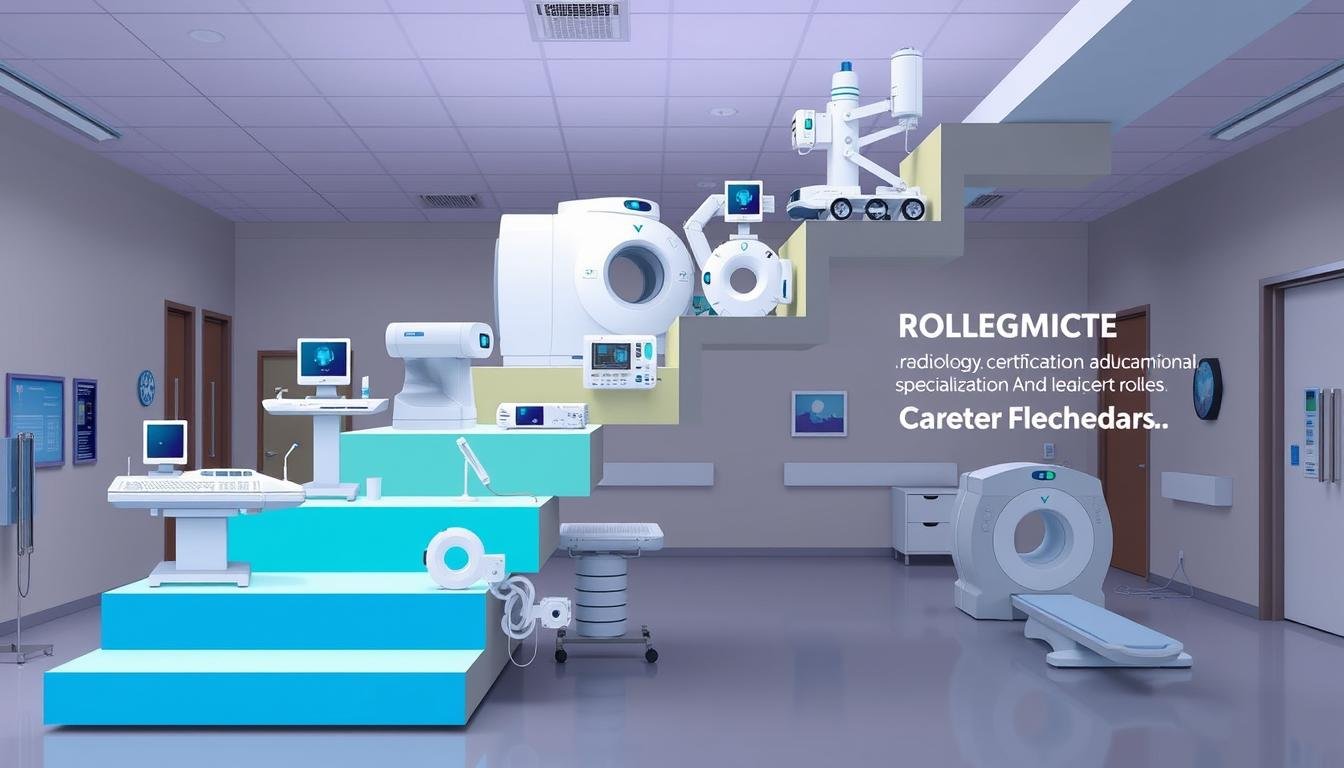Becoming a radiology technician can be exciting and rewarding. This job offers steady work and good pay.
We’ll explore radiology technician salaries and job prospects and examine ways to advance in radiologic technology.
This is a visually striking illustration of a radiology technician at work in a modern hospital setting, surrounded by high-tech imaging equipment like MRI and ultrasound machines. Dollar bills are subtly integrated into the background to symbolize salary and financial success. The scene should convey professionalism and expertise, focusing on the technician’s precise movements and concentration, bathed in soft, clinical lighting.
Radiology technology offers various salary options. The Bureau of Labor Statistics reports a median yearly salary of $61,370.
Earnings can change based on location and work setting. Specialization also affects how much you can make in this field.
Overview of Radiology Technician Salaries
Radiology techs in the United States earn competitive salaries. In 2021, the median annual pay for radiologic technologists was $61,370.
New radiology techs usually earn around $44,000 per year, while experienced technologists can make up to $75,000 annually.
Radiology tech salaries are higher than many other healthcare jobs. Medical assistants earn about $35,000, while phlebotomists make around $36,000 yearly.
Factors Affecting Radiology Tech Salaries
Education level and certifications impact radiology tech salaries. Advanced degrees and specialized certifications can lead to higher earnings.
Geographic location plays a role in salary differences. High-cost areas often offer better pay for radiology techs.
Work settings influence income, too. Hospitals typically pay more than outpatient clinics or imaging centers.
Education, certification, location, and work environment shape earning potential. Understanding these factors helps professionals make smart career choices.
Top-Paying States for Radiology Techs
California, Massachusetts, and Hawaii offer the highest salaries for radiologic technologists. In California, radiology techs earn an average of $77,560 annually.
Massachusetts follows with $75,120 per year. Hawaii offers an impressive $74,490 annually for radiologic technologists.
These states have a thriving job market for radiology techs. California’s demand is high, and job growth is expected to be 9%.
The state’s diverse healthcare landscape provides many job opportunities. Urban and rural areas need skilled radiologic technologists.
When comparing top-paying states, consider the cost of living. Higher living costs can affect the value of earnings.
Still, these states remain prime destinations for radiology techs. They offer excellent opportunities to maximize earning potential.
Salary by Work Setting
Radiology technicians’ salaries vary based on their work environment. Healthcare facilities offer different pay for radiologic technologists.
Hospitals pay the highest, with average annual salaries around $60,000. This is due to high patient numbers and diverse imaging procedures.
Outpatient centers and private practices pay less, averaging $55,000 yearly. Government and military facilities offer competitive pay, often exceeding $57,000 annually.
This higher pay is for specialized work and skilled personnel. Understanding these salary differences helps aspiring professionals make informed career choices.
Specializations and Their Impact on Salary
Radiology technicians can choose from various career paths. Specializing in CT, MRI, or mammography can boost your earning potential.
These subspecialties often require extra training and certification. However, the investment can lead to higher salaries.
Techs specializing in CT and MRI tend to earn more. The demand for these skills is high, leading to competitive pay.
Mammography and interventional radiology specialists also see increased earnings. Their specialized knowledge and skills are highly valued.
Specializing opens up more job opportunities. Employers often prefer candidates with expert knowledge in specific areas.
Staying current with industry trends can help advance your career, and expanding your skills can lead to higher earnings as a radiology technician.
Career Advancement and Salary Growth
Radiologic technologists can explore paths for career growth. They can pursue management roles or become radiology department supervisors.
These positions often come with higher salaries. They involve overseeing operations, staff, and budgets.
Another option is earning advanced degrees in radiologic sciences. This can lead to specialized roles and teaching opportunities.
Individuals with advanced degrees can expect a radiologic technologist salary advancement. This is compared to those with only an associate’s degree.
Obtaining additional certifications can boost skills and earning potential. Popular certifications include mammography, CT, and MRI.
These specialized skills are in high demand. They can contribute to a radiology tech career progression and higher salaries.
This is a visual representation of the career progression of a radiology technician. It features a staircase made of various medical imaging equipment, such as X-ray machines, MRI scanners, and CT scanners. Each step symbolizes different career milestones such as education, certification, specialization, and leadership roles. The staircase is surrounded by a modern healthcare environment and bright and engaging colors to emphasize growth and opportunity.
Radiologic technologists can position themselves for increased responsibilities. This leads to greater job satisfaction and higher earning potential.
Benefits and Compensation Packages
Radiology technicians enjoy many benefits and great pay. They get health insurance, retirement plans, and paid time off.
Radiologic technologists receive a good salary and benefits package. Employers offer health, dental, and vision insurance for techs and their families.
Retirement plans like 401(k) or pensions help techs plan for the future. Employers often fund continuing education courses and industry conferences.
Certification programs enable technicians to grow their skills and paid time off allows radiology techs to balance work and personal life.
These benefits make radiologic technology a rewarding career. Good pay and growth opportunities lead to job satisfaction and financial stability.
Job Outlook and Growth Projections
Radiology technicians have a bright future ahead. Jobs in this field are growing faster than average, with a 9% increase expected by 2031.
This growth comes from the increased number of people needing imaging tests. As the population ages, the demand for healthcare services increases.
New tech is also helping the job market. Digital imaging and telemedicine are making radiology more efficient.
The focus on early disease detection is increasing job opportunities for radiologic technologists. They can work in hospitals, clinics, and imaging centers.
This career path offers substantial growth and chances to move up. Skilled radiology pros will stay in high demand as healthcare changes.
Negotiating Salary as a Radiology Tech
Negotiating your salary is crucial for radiology techs—research market rates for your position and skills in your area.
Check salary data from industry sources and job postings. This will help you understand typical pay ranges.
Be ready to showcase your unique qualifications. Highlight your specialized training, certifications, and additional skills.
Show how you’ve improved patient outcomes or streamlined workflow. This demonstrates your value to the organization.
Timing is key for radiology tech salary negotiation. Good times include job offers, performance reviews, or role changes.
Approach the talk with a team-player attitude. Focus on finding a win-win solution, not making demands.
Effective radiologic technologist pay discussions require confidence and research. Understanding the market can help you position yourself for a rewarding career.
Part-Time and Per Diem Opportunities
Part-time and per diem jobs offer flexibility for radiologic technologists. These roles allow work as needed, promoting a balanced work-life schedule.
Hourly rates for part-time jobs often match full-time positions, making them great for supplementing income or maintaining a flexible lifestyle.
Flexible work options cater to the individual needs of radiologic technologists. They accommodate family responsibilities, further education, or more personal time.
These opportunities empower technologists to control their careers. They can set their schedules and prioritize their well-being.
Consider trade-offs like benefits and job security with these positions. However, many value the increased autonomy and work-life balance more.
Growing healthcare demand has increased flexible work options. This provides a promising career path for those seeking customizable professional journeys.
International Opportunities and Salaries
Radiology technicians can find jobs worldwide. Pay varies by country due to living costs and healthcare systems.
Salaries in Canada, the UK, and Australia range from $50,000 to $70,000 yearly. India and parts of Asia offer $10,000 to $25,000 per year.
Working abroad often requires special licenses. Check the host country’s rules before applying.
Global healthcare needs more skilled radiologic technologists. This field offers great chances to work worldwide.
Techs can enjoy new cultures and different healthcare systems. They may also get good pay and benefits.
Future Trends in Radiology Tech Salaries
The healthcare industry is changing fast, and this is affecting radiology technician salaries. AI and automation in medical imaging are reshaping radiologic technologists’ roles.
These changes may lead to new pay structures. Telemedicine and remote imaging services also create new opportunities for radiology professionals.
These skills may lead to higher pay. Specialties like interventional radiology and mammography are growing.
Demand for these skills is rising, which could boost salaries. Radiology techs who adapt to new technology will do well.
Learning new skills is key. Staying current with trends helps, and this can lead to better pay and career growth.
FAQ
How much does a radiology tech make?
The median yearly salary for radiology technicians is about $61,370, according to the Bureau of Labor Statistics for 2021.
Salaries can change based on experience, location, specialty, and work setting.
What are the top-paying states for radiology techs?
California, Hawaii, Washington, Massachusetts, and Alaska most pay radiology technicians. These states offer higher pay due to living costs and demand.
How does a radiology tech’s salary compare to other healthcare professions?
Radiology technicians earn more than medical assistants or nursing aides. However, they make less than radiologists, who are medical doctors.
What factors can affect a radiology tech’s salary?
Education, certifications, experience, skills, location, and workplace type affect a tech’s salary, which can lead to higher or lower pay.
Can a radiology tech’s salary increase through career advancement?
Yes, radiology technicians can boost their earnings through career growth. They can take on leadership roles or get advanced certifications.
Further education to become a radiologist assistant can also increase pay.
Are there opportunities for part-time or per diem work as a radiology tech?
Yes, part-time and per diem work is often available for radiology technicians. These jobs may offer higher hourly rates but fewer benefits.
What are the future salary trends for radiology techs?
The job outlook for radiology technicians is strong, with 9% growth expected. However, new technology and industry changes may affect future salaries.
you may also read:What Is a Surgical Tech: Career Overview & Requirements

